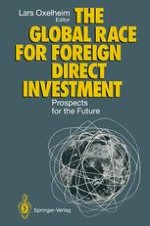1993 | OriginalPaper | Buchkapitel
Foreign Direct Investment and the Liberalization of Capital Movements
verfasst von : Lars Oxelheim
Erschienen in: The Global Race for Foreign Direct Investment
Verlag: Springer Berlin Heidelberg
Enthalten in: Professional Book Archive
Aktivieren Sie unsere intelligente Suche, um passende Fachinhalte oder Patente zu finden.
Wählen Sie Textabschnitte aus um mit Künstlicher Intelligenz passenden Patente zu finden. powered by
Markieren Sie Textabschnitte, um KI-gestützt weitere passende Inhalte zu finden. powered by
In the 1980s a surge of foreign direct investment (FDI) occurred on a global scale with the total value of inflows reaching about USD 185 billion in 1989.1 The growth came about at an unprecedented high rate during the latter part of the 1980s and the inflow of 1989 was three to four times the average flow in the first half of the decade. The average annual growth rate between 1985 and 1990 was 34 percent. However, growth was rather unevenly distributed. The developing world experienced a drying-up of inflows and its share of global flows fell from an annual average of about 24 percent in 1975–79 to about 14 percent in 1985–89.2 At the same time, successful economies in Asia siphoned the flows away from the heavily indebted countries in Africa and Latin America. The bulk of the increase in FDI flows in the latter part of the 1980s took place almost entirely between developed countries, with a heavy concentration in the countries of the Triad: the United States, the European Community and Japan. In the aggregate, direct investment flows amounted to well over 1 percent of GNP in fourteen major industrial countries by 1989, compared to about.5 percent of GNP in the early 1980s.3 Since this increase is higher than that for gross domestic investment, it can hardly be attributed entirely to cyclical factors.4
